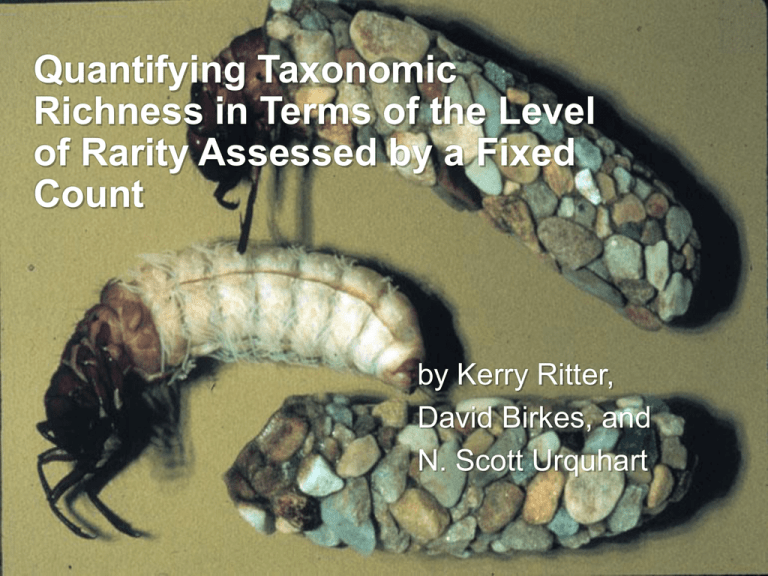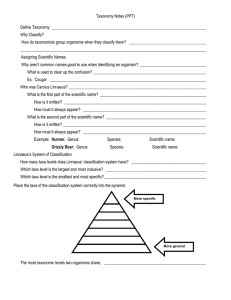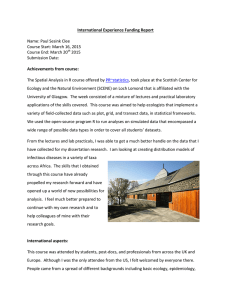Quantifying Taxonomic Richness in Terms of the Level Count
advertisement

Quantifying Taxonomic Richness in Terms of the Level of Rarity Assessed by a Fixed Count by Kerry Ritter, David Birkes, and N. Scott Urquhart FUNDING SOURCE 2 This presentation was developed under the STAR Research Assistance Agreement CR-829095 awarded by the U.S. Environmental Protection Agency (EPA) to Colorado State University. This presentation has not been formally reviewed by EPA. The views expressed here are solely those of its authors and the STARMAP Program. EPA does not endorse any products or commercial services mentioned in this presentation. Overview 3 Numerical Taxa Richness (NTR) Problem and Motivation Proposed Solution Jackknife Alternative Future Research What is Numerical Taxonomic Richness (NTR)? 4 NTR= number of taxa observed for a fixed (relatively small) number of individuals subsampled from a larger collection Saves time and money Provides fair comparisons among sites Effective measure of habitat quality What is NTR “really” estimating? 5 Population = Collection Underestimates total number of taxa in the collection. NTR effectively targets total number of “non-rare” taxa Why do we care? 6 A good idea to know what we're measuring Better understanding of how impacts affect benthic composition Weigh cost (ss) against resolution Develop alternatives Potential to correct for unequal sized subsamples NTR Depends on Subsample Size 7 As subsample size Number of taxa Likelihood of observing rare taxa Sensitivity to disturbance Target Parameter, C*(h) 8 C*(h) = total # of taxa in the collection with relative frequency ≥ h Goal: Determine h for a given subsample size, n Zipf’s Law for Relative Frequency of Taxa Sizes Let pi = relative frequency of ith taxon Then the proportion of taxa having relative frequency pi pi - (1+ ) – 9 Hill, 1974 Lemma 10 Assume pi’s follow Zipf’s Law, for 0 < < 1 Then the # of taxa observed in the subsample of size n is approximately unbiased for C*(h) – where h = 1/ 2n * – and = ((1- )(5 - ))1/2 - (1- ) Data 11 OSU/EPA 1992-1993 pilot study 7 composite samples of macroinvertebrates Reflect a variety of taxa distributions with regard to CV and proportion of “rare” taxa Approximation for h 12 Fit Pareto distribution to the data – (Pareto is continuous analogue of Zipf's law) From 7 composites: [0.23, 0.43] – => [1.04, 1.15] We chose = 1 h = 1/ 2n Simulation Study I 13 7 composites 10,000 random subsamples (with replacement) Individuals within each subsample randomly selected (without replacement) n = 50, 100, 250, 500 Evaluated bias of NTR with respect to C*(1/ 2n) and C NTR wrt C and C*(1/2n) Figure 1 Relative Bias (%) 40 20 0 -20 -40 C* C -60 -80 0 100 200 300 Subsample Size (n) 14 400 500 Finding 1 15 NTR based on a subsample of size n is “nearly” unbiased for number of taxa which occur in the collection with relative frequency ≥ 1/ 2n Converse of Finding 1 16 To estimate number of taxa which occur in the collection with relative frequency ≥ h, use NTR based on a subsample size 1/ 2 h. Jackknife Alternative 17 Bias as a function of subsample size Finding 2: Jackknife based on a subsample of size n is nearly unbiased for C*(1/ 5n). Converse: Jackknife based on a subsample of size 1/ 5h is nearly unbiased for C*(h). Jack(n = 1/ 5 h) vs. NTR(n = 1/ 2 h) for Estimating C*(h) 18 Bias (Jack) Bias(NTR) SD(Jack) 2 SD(NTR) RMSE(Jack) 3/2 RMSE(NTR) Summation 19 NTR is “nearly unbiased” for # of taxa with relative frequency ≥ 1/ 2n. Jackknife is “nearly unbiased” for # of taxa with relative frequency ≥ 1/ 5n. Comparable bias with NTR can be achieved with Jackknife when subsample size is reduced by 60%. Future Research 20 Develop a correction factor that will allow for “fair” comparison with NTR for arbitrary subsample size Contacts 21 kerryr@sccwrp.org birkes@stat.orst.edu nsu@stat.colostate.edu






